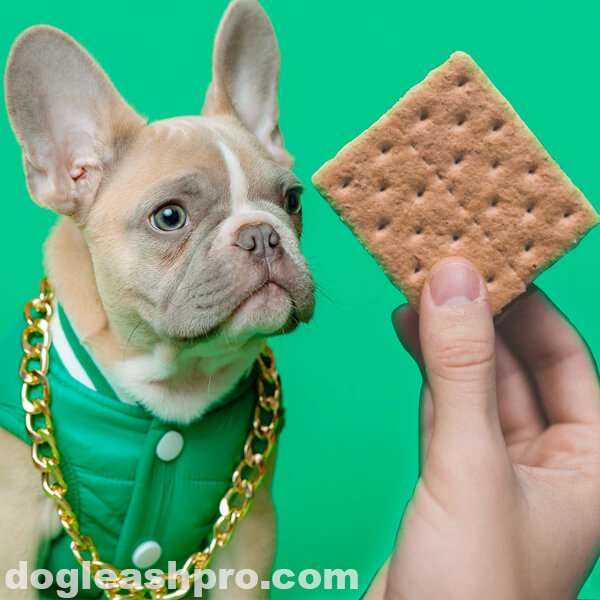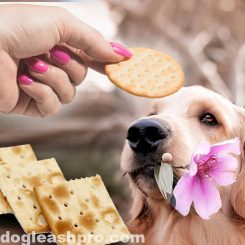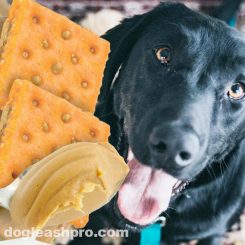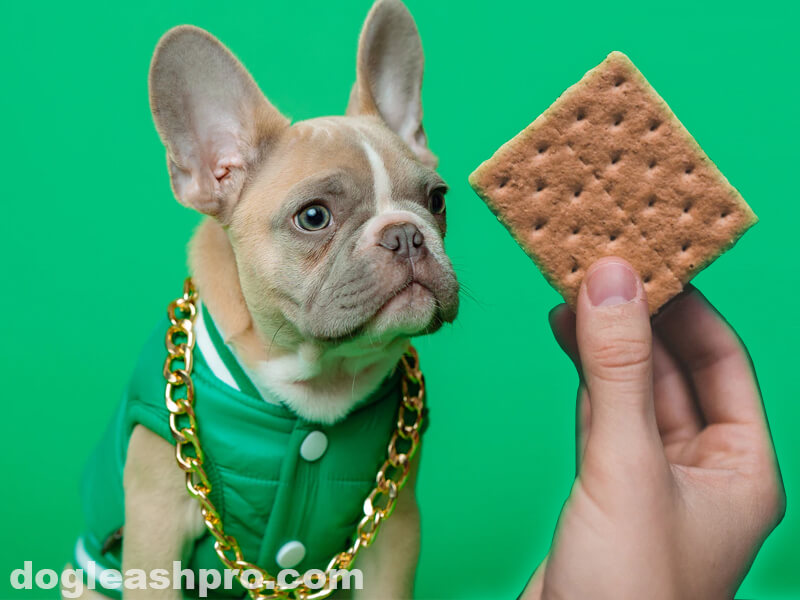
From Wheat Thins to Graham Crackers, my family loves snacking on crackers with a hot cup of tea. Last weekend, we decided to make s’mores with Graham Crackers. It was a fun family activity filled with story-telling and laughter. Since chocolate was involved, we had to make sure our dogs couldn’t reach them. But what about the Graham Crackers? In this article, we’ll explore whether Graham Crackers are safe for doggy consumption.
Can Dogs Eat Graham Crackers? No, dogs should not eat Graham Crackers. Graham Crackers contains high levels of salt, fats, sugar, and carbohydrates. All of these are harmful to your dog’s health. If you must, allow your dog to eat no more than one Graham Cracker occasionally and as a rare treat.
Table of Contents
Can dogs have Graham Crackers?
Ideally, dogs should not have Graham Crackers. While Graham Crackers do not contain any toxic ingredients, they are packed full of salt, sugar, fats, and carbohydrates. All of these are recipes for disaster when it comes to our furry friend’s health.
Are Graham Crackers bad for dogs?
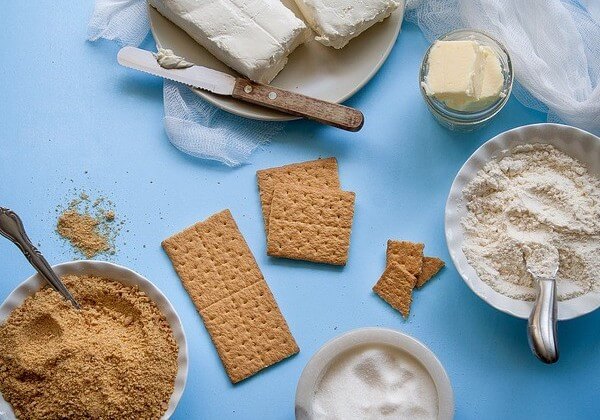
To better understand why Graham Crackers are bad for dogs, let’s take a look at the ingredients in Graham Crackers.
Ingredients in Graham Crackers
- Unbleached enriched flour which includes wheat flour, niacin, reduced iron, thiamine mononitrate (vitamin B1), riboflavin (vitamin B2).
- Folic acid.
- Graham flour which includes whole-grain wheat flour.
- Sugar.
- Canola oil.
- Molasses.
- Palm oil.
- Leavening which includes baking soda and/or calcium phosphate.
- Salt.
Unbleached enriched flour is unsafe for dogs with wheat allergy
If your K9 friends are sensitive to wheat products or are allergic to wheat, please avoid feeding them Graham Crackers. The unbleached enriched flour in Graham Crackers is mainly made of wheat flour.
Dogs are usually not allergic to wheat. However, through constant exposure to wheat products, the sensitivity to wheat may heighten and develop into wheat allergy.
If you’re not sure whether your furry friends are allergic to wheat flour, consider giving them a tiny amount of Graham crackers. If they react with the following symptoms, then they may have a wheat allergy:
- Vomiting.
- Bloating.
- Diarrhea.
- Asthma.
- Itchy and red skin.
- Skin rashes or inflammation.
- Frequently licking of the front paws and paw pads.
- Sneezing.
- Changes in behaviors.
- Itchy anal leading to dogs dragging their bottoms on the floor.
- Seizure (in severe cases).
We highly recommend that you contact your vet immediately and confirm your dog’s symptoms of wheat allergy. Your vet may ask you to bring your furry friends in for a check-up. This will allow the vet to perform allergy testing to confirm whether they have a wheat allergy or other types of allergy you were aware of.
If you’re wondering why it is called enriched flour, it is because during the wheat to flour processing, many of the natural nutrients in the wheat were lost. In order to restore the original nutrients, the flour is then enriched with essential nutrients like niacin (Vitamin B3), reduced iron, thiamine mononitrate (Vitamin B1), and riboflavin (Vitamin B2).
While iron and B vitamins are essential to our four-legged friend’s health, it’s best that our pooch receive these necessary nutrients from their regular dog food and not from human snacks like Graham Crackers.
Folic acid is essential for maintaining normal metabolism in dogs
Folic acid is also known as Vitamin B9. Our canine friends need folic acid because it helps with the following:
- Red blood cell production and development.
- Tissue repair.
- Neurotransmitters and neural health.
- Hormones.
- DNA synthesis.
- Immune health.
- Digestive tract support and maintenance.
- Fetal development.
- General metabolic functions.
Folic acid is great for dogs that have a folic acid deficiency. However, if your pooch has a folic acid deficiency, there are plenty of dog-friendly folic acid supplements to take instead of eating Graham Crackers.
Canine-friendly vegetables like Brussel Sprouts, eggs, kale, broccoli, and flax seeds are high in folate and would be a great treat or addition to your dog’s main meal.
Graham flour is safe for dogs that do not have a wheat allergy
The signature ingredient in Graham Crackers is Graham flour and it is made from whole grain wheat flour. This means that if your dogs are allergic to wheat or are sensitive to wheat products, it’s best not to feed them Graham Crackers.
When it comes to whole grain wheat flour, it is safe for dogs to eat but keep in mind that our canine friends don’t really need flour in their diet at all. In fact, grains are not a natural food for our pups. When it comes to our dog’s diet, it’s best to stick to meat for protein, fruits, and vegetables.
If you still prefer to feed your pooch a diet that includes whole grain flour, we highly recommend that you choose whole ground flours from buckwheat, barley, oats, quinoa, or peas. Some non-grain flour options can include coconut, hazelnut, almond, and potato flour. Be sure your furry family member is not allergic to nuts before feeding them flours that contain nuts.
Sugar is unnecessary and harmful to dogs

If you’re wondering, “how much sugar in Graham Crackers?” let’s take a look at one of the most popular brands of Graham Cracker to find out.
In just one Nabisco original Graham Cracker, there is 1 gram of sugar. The sugar used to make Graham Crackers is table sugar and our furry family members do not need table sugar in their diet.
In fact, a well-balanced wholesome doggy diet should include carbohydrates. When dogs ingest food with carbohydrates, it converts to simple sugars that your dogs are able to easily absorb. The amount of sugar they absorb from carbohydrates in their dog food should be enough for that day.
Thus, any excess sugar intake from snacks like Graham Crackers is harmful to our four-legged friends because it can go over the sugar intake limit and lead to excessive sugar consumption.
Regularly consuming sugar can lead to negative health problems such as:
- Weight gain; regularly eating sugary food can lead to canine obesity.
- Dental issues: cavities, loss of enamel, tooth decay, and eventually tooth loss.
- Diabetes (Type I Diabetes is very common in dogs).
- Changes in your dog’s metabolism cause lower energy levels, loss of muscle tone, and an increase in fat storage.
It’s important to note that 80% of dogs are affected by canine periodontal disease by the time they are 3 years of age. Since gum disease and periodontal disease in dogs are very common, let’s not contribute to that problem.
Did you know? There are 0.8 grams of sugar in 1 Peanut Butter Cracker. Check out our article, Can Dogs Eat Peanut Butter Crackers to find out if this crunchy snack is safe for your dogs to eat.
Molasses in small amounts is safe for dogs
Molasses is a sweetener that comes from beet sugar or cane, thus it is a natural sweetener. Adding a small amount of this sweetener, without any added chemicals, to their food can be a perfect supplement. That’s because molasses contain the following essential nutrients and vitamins:
- Calcium.
- Magnesium.
- Manganese.
- Vitamin B6.
- Iron.
- Copper.
- Selenium.
- Potassium.
Note that not all molasses are the same. Some molasses contain xylitol, which is a sugar-free sweetener that is extremely toxic to our K9 friends. Before you add some molasses to your dog’s food or treat, be sure it is natural and no other artificial sweeteners were added.
Palm oil is extremely toxic to dogs
Unfortunately, palm oil is dangerous to our canine friends. If your pooch got a taste of the palm oil, we highly recommend that you contact your vet immediately and seek immediate help and treatment.
After eating food that contains palm oil, your pooch may experience the following symptoms:
- Diarrhea.
- Vomiting.
- Extreme dehydration.
- Blockage in the gastrointestinal tract (in severe cases with large consumption).
- Liver failure (in severe cases with large consumption).
- Kidney damage (in severe cases with large consumption).
For this reason, we highly advise that you do not feed Graham Crackers to your pooch.
Canola oil is fine for dogs
Canola oil is fine for dogs because it is not toxic, however, it is not the best type of oil for your furry friends. We recommend the following types of oil to share with your canine friends as these contain natural fat and healthy oil:
- Fish oil: improves your dog’s coat and skin health, soothes inflammation caused by allergies with the help of omega-3 fatty acids (EPA and DHA).
- Coconut oil: Moisturizes your dog’s skin and provides a shiny healthy coat. It can also help with any gut issues in dogs. Many dog owners also rub a little bit of coconut oil on their dog’s teeth to help remove tartar and plaque buildup.
- Olive oil: Be sure to feed your pooch 100% olive oil and not olive oil that is mixed with other types of oil like canola oil. Olive oil contains good fats that help provide healthy skin and coat for dogs, improve their immune system, and prevent cardiovascular disease and diabetes in dogs.
- Sunflower oil: This type of oil is great for dogs because it contains omega-6 fatty acids, which promotes a healthy heart in dogs and keep their coat shiny and healthy with smooth skin.
- Flaxseed oil: Flaxseed oil is great for dogs with high blood pressure, kidney problems, arthritis. It also acts as an allergy relief to dogs and eases inflammation. Flaxseed oil is also a great substitute if your canine friends are allergic to fish oil or seafood.
Fun Fact: Many popular snacks like Goldfish use canola oil. Find out if Goldfish crackers are safe for dogs to eat and how many Goldfish crackers can a dog have in our article, Can Dogs Eat Goldfish?
Leavening is not necessary for a dog’s diet
Our canine friends do not need leavening agents such as baking soda in their diet. Also, dogs can get their calcium or phosphorus from proper nutritious dog food and not from leavening agents.
Excessive Salt can cause sodium poisoning in dogs
There is 21.3 mg of salt in one Nabisco original Graham Cracker. While that is not a lot of salt for us, it is definitely too much salt for our furry friends. Keep in mind that our canine pups only require 0.25 grams to 1.5 grams of salt for every 100 grams of food.
Accidentally eating more than one Nabisco original Graham Cracker can lead to sodium poisoning in dogs with signs and symptoms that include:
- Excessive thirst leading to frequent urination.
- Swelling lips, mouth, and tongue.
- Diarrhea.
- Vomiting.
- Appetite loss.
- Nausea.
- Headache.
- Watery stool.
- Diarrhea.
- Muscle spasms, tremors, and weakness.
- Tachycardia or increased heart rate.
- Convulsions.
- Breathing difficulty.
- Walking wobbly or acting drunk.
- Lethargy.
Are Graham Crackers good for dogs?
Based on the ingredients above, it’s safe to say that Graham Crackers are not good for dogs. If you must, you can give your pooch one Graham Crackers and no more than that.
Let’s also take a look at the nutritional profile of the Graham Crackers:
Nabisco Original Graham Crackers Nutritional profile (1 Cracker or 3.9 grams)
| Name, Unit | Amount |
| Calories, cal | 16.3 |
| Total Fat, g | 0.4 |
| Saturated Fat, g | 0.1 |
| Sodium, mg | 21.3 |
| Total Carbohydrate, g | 3 |
| Dietary Fiber, g | 0.1 |
| Total Sugars, g | 1 |
| Protein, g | 0.3 |
| Calcium, mg | 2.5 |
| Potassium, mg | 7.5 |
| Iron, mg | 0.14 |
This means that a single Nabisco original Graham Cracker contains about 16 calories, 0.4 grams of fat (0.1 grams saturated), and 3 grams of carbohydrate (1 gram of sugar).
As you can see, almost 71% is carbohydrates, 23% fat, and only 6% protein in Graham Crackers. Since dogs should already receive their carb intake from their regular dog food, eating Graham Crackers would mean that they are consuming too many carbs.
Fats are also dangerous for our pooch because they can cause canine obesity in dogs and can even cause arthritis, joint problems, heart problems, and pancreatitis in dogs.
Graham Crackers and Dogs: Different Types
Can dogs eat Scooby Snacks?
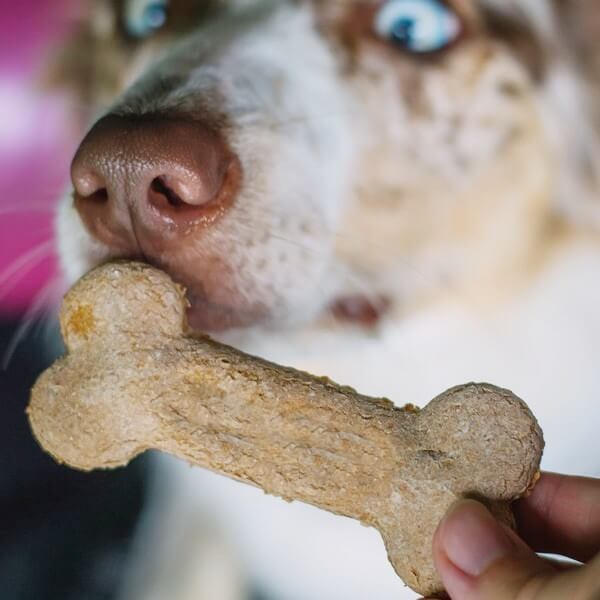
If you’re wondering, “Can Dogs Eat Scooby Doo Graham Crackers?” the answer is no, dogs should not eat Scooby Doo Graham Crackers or Scooby Snacks.
To find out why, let’s take a look at the ingredients in Scooby Snacks below.
Scooby Snacks Ingredients
- Whole wheat flour.
- Enriched flour from wheat flour, niacin, reduced iron, vitamin B1 (thiamin mononitrate), vitamin B2 (riboflavin), and folic acid.
- Sugar.
- Soybean and palm oil.
- Honey.
Scooby Doo snacks ingredients contain 2% or less of the following:
- Salt.
- Baking soda.
- Cinnamon.
- Maltodextrin.
- Soy lecithin.
- BHT for freshness.
Nutritional Profile of Scooby-Doo Graham Crackers (1 Pouch or 28 grams)
| Name, Unit | Amount |
| Calories, cal | 120 |
| Sugar, g | 8 |
| Sodium, mg | 115 |
| Total Carbohydrate, g | 21 |
| Total Fat, g | 3.5 |
| Saturated Fat, g | 1 |
| Protein, g | 2 |
| Fiber, g | 1 |
| Iron, mg | 0.7 |
| Potassium, mg | 50 |
So, can dogs have Scooby snacks?
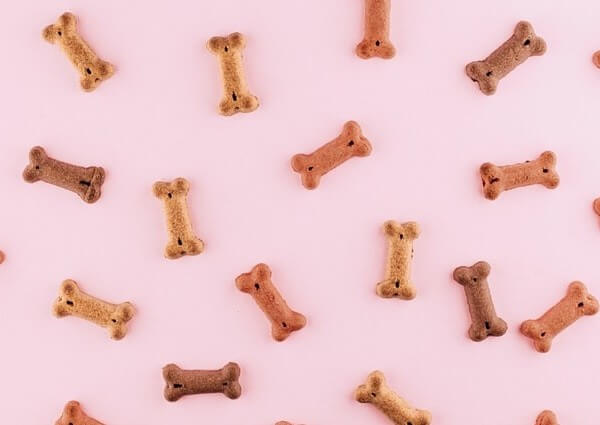
As we can see from the ingredients and nutritional profile above, dogs should not have Scooby snacks since Scooby Doo Graham Crackers contain ingredients that are not healthy for doggy consumption.
Many of the ingredients found in Kelloggs Scooby Doo Graham Crackers are similar to the ingredients found in your typical Graham Crackers, namely whole wheat flour, enriched flour, sugar, as well as palm and soybean oil.
We’ve discussed above how some of these ingredients are not safe for dogs.
Additionally, if we take a look at the nutritional profile of just 1 pouch or 28 grams of Scooby Doo Graham Crackers, we can see that this snack is high in calories, sodium, carbohydrates, fat, and sugar. This makes Scooby snacks bad for canine consumption.
Can dogs eat cinnamon Graham Crackers?
Cinnamon Graham Crackers aren’t necessarily toxic to dogs. If your pooch is not allergic to cinnamon, then he or she should be fine. It’s important that dogs should only eat cinnamon Graham Crackers as a rare treat and not on a regular basis.
Since Graham Crackers in general aren’t the best snack for dogs, we do not recommend feeding them to your pooch. There are plenty of dog-friendly snacks to consider instead of cinnamon Graham Crackers.
Can I give my dog cinnamon Graham Crackers?
Yes, you can give your dog one cinnamon Graham Crackers since they are not toxic to dogs. However, they aren’t the healthiest treat or snack for dogs and there are several ingredients in Graham crackers that aren’t safe or good for dogs.
If your pooch is allergic to wheat, please avoid feeding them cinnamon Graham Crackers.
So, can dogs eat Graham Crackers?
Ideally, it is best not to feed our dogs Graham Crackers. If you must, you can offer them one Graham Cracker as a rare treat. It is best that dog owners do not feed their pups Graham Crackers regularly as this could lead to many health problems in dogs such as diabetes, dental issues, weight gain, heart problems, arthritis, and joint pain.
What we feed our dogs heavily affects their happiness, energy level, and behavior. Eating the wrong food or unhealthy food can cause lethargy in dogs and this can cause them to feel sad or act out. So before you feed them a Graham Cracker or two, keep this in mind.
Related Questions
Graham Crackers are fine for dogs that do not have wheat allergies. If you must feed your pooch Graham Crackers, keep it to one or two and no more than that. Graham Crackers are high in salt, sugar, fats, and carbohydrates so they are not really healthy for canine consumption.
There are also some ingredients in Graham Crackers that are not healthy or safe for dogs.
Ideally, dogs should not eat Graham Crackers, but if you must feed your dog Graham Crackers, keep it to one or two. Graham Crackers aren’t the best snacks for dogs because they are packed full of salt, sugar, fats, and carbohydrates.
Ingesting too much salt can cause sodium poisoning in dogs and too much sugar consumption can cause unnecessary weight gain that can lead to obesity, diabetes, and dental issues in dogs. For these reasons, keep Graham Crackers away from dogs.
Dogs should not eat chocolate Graham Crackers. Although there’s not much chocolate in Graham Crackers to cause serious danger to your dogs, we highly recommend that pet owners do not feed their dogs any amount of chocolate.
Chocolate is actually toxic to dogs because it contains a chemical called theobromine, which can cause chocolate toxicity in dogs. This can lead to symptoms such as diarrhea, vomiting, upset stomach, muscle tremors, and internal bleeding in dogs. Keep in mind that chocolate also contains caffeine, which can cause quick heart rate and heart attack in dogs.
DISCLAIMER: THIS WEBSITE DOES NOT PROVIDE MEDICAL ADVICE
The information, including but not limited to, text, graphics, images and other material contained on this website are for informational purposes only. No material on this site is intended to be a substitute for professional veterinary advice, diagnosis, or treatment. Always seek the advice of your veterinarian or other qualified health care provider with any questions you may have regarding dietary needs.
Resources:
https://en.wikipedia.org/wiki/Graham_cracker
https://www.entrepreneur.com/article/252725

With over five years of specialized experience as an animal writer, my expertise lies in dog nutrition, health, behavior, grooming, and training. I am dedicated to delivering helpful and informative content that caters to the well-being of our furry friends. My primary goal is to empower pet owners with knowledge and ensure our canine companions thrive in health and happiness. In my free time, I love volunteering at local dog rescue centers.
